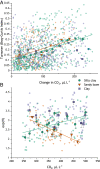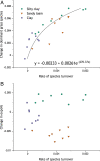Multiple constraints cause positive and negative feedbacks limiting grassland soil CO2 efflux under CO2 enrichment
- PMID: 33419921
- PMCID: PMC7812833
- DOI: 10.1073/pnas.2008284117
Multiple constraints cause positive and negative feedbacks limiting grassland soil CO2 efflux under CO2 enrichment
Abstract
Terrestrial ecosystems are increasingly enriched with resources such as atmospheric CO2 that limit ecosystem processes. The consequences for ecosystem carbon cycling depend on the feedbacks from other limiting resources and plant community change, which remain poorly understood for soil CO2 efflux, JCO2, a primary carbon flux from the biosphere to the atmosphere. We applied a unique CO2 enrichment gradient (250 to 500 µL L-1) for eight years to grassland plant communities on soils from different landscape positions. We identified the trajectory of JCO2 responses and feedbacks from other resources, plant diversity [effective species richness, exp(H)], and community change (plant species turnover). We found linear increases in JCO2 on an alluvial sandy loam and a lowland clay soil, and an asymptotic increase on an upland silty clay soil. Structural equation modeling identified CO2 as the dominant limitation on JCO2 on the clay soil. In contrast with theory predicting limitation from a single limiting factor, the linear JCO2 response on the sandy loam was reinforced by positive feedbacks from aboveground net primary productivity and exp(H), while the asymptotic JCO2 response on the silty clay arose from a net negative feedback among exp(H), species turnover, and soil water potential. These findings support a multiple resource limitation view of the effects of global change drivers on grassland ecosystem carbon cycling and highlight a crucial role for positive or negative feedbacks between limiting resources and plant community structure. Incorporating these feedbacks will improve models of terrestrial carbon sequestration and ecosystem services.
Keywords: CO2 enrichment; biodiversity; productivity; soil respiration; tallgrass prairie.
Conflict of interest statement
The authors declare no competing interest.
Figures





Similar articles
-
Plant community change mediates the response of foliar δ(15)N to CO 2 enrichment in mesic grasslands.Oecologia. 2015 Jun;178(2):591-601. doi: 10.1007/s00442-015-3221-x. Epub 2015 Jan 22. Oecologia. 2015. PMID: 25604918
-
Flowering in grassland predicted by CO2 and resource effects on species aboveground biomass.Glob Chang Biol. 2018 Apr;24(4):1771-1781. doi: 10.1111/gcb.14032. Epub 2018 Jan 28. Glob Chang Biol. 2018. PMID: 29282824
-
Feedback from plant species change amplifies CO2 enhancement of grassland productivity.Glob Chang Biol. 2012 Sep;18(9):2813-23. doi: 10.1111/j.1365-2486.2012.02735.x. Epub 2012 Jun 12. Glob Chang Biol. 2012. PMID: 24501059
-
Integrating the evidence for a terrestrial carbon sink caused by increasing atmospheric CO2.New Phytol. 2021 Mar;229(5):2413-2445. doi: 10.1111/nph.16866. Epub 2020 Oct 21. New Phytol. 2021. PMID: 32789857 Review.
-
Decreased atmospheric nitrogen deposition in eastern North America: Predicted responses of forest ecosystems.Environ Pollut. 2019 Jan;244:560-574. doi: 10.1016/j.envpol.2018.09.135. Epub 2018 Oct 10. Environ Pollut. 2019. PMID: 30384062 Review.
Cited by
-
Low precipitation due to climate change consistently reduces multifunctionality of urban grasslands in mesocosms.PLoS One. 2023 Feb 3;18(2):e0275044. doi: 10.1371/journal.pone.0275044. eCollection 2023. PLoS One. 2023. PMID: 36735650 Free PMC article.
-
Interactions among nutrients govern the global grassland biomass-precipitation relationship.Proc Natl Acad Sci U S A. 2025 Apr 15;122(15):e2410748122. doi: 10.1073/pnas.2410748122. Epub 2025 Apr 11. Proc Natl Acad Sci U S A. 2025. PMID: 40215280
References
-
- Rockström J., et al. , A safe operating space for humanity. Nature 461, 472–475 (2009). - PubMed
-
- IPCC , Climate Change 2013: The Physical Science Basis. Contribution of Working Group I to the Fifth Assessment Report of the Intergovernmental Panel on Climate Change (Cambridge University Press, Cambridge, United Kingdom, 2013).
-
- Bond-Lamberty B., Thomson A., Temperature-associated increases in the global soil respiration record. Nature 464, 579–582 (2010). - PubMed
-
- Bond-Lamberty B., Bailey V. L., Chen M., Gough C. M., Vargas R., Globally rising soil heterotrophic respiration over recent decades. Nature 560, 80–83 (2018). - PubMed
-
- Raich J. W., Schlesinger W. H., The global carbon dioxide flux in soil respiration and its relationship to vegetation and climate. Tellus 44b, 81–99 (1992).
Publication types
MeSH terms
Substances
Associated data
LinkOut - more resources
Full Text Sources

